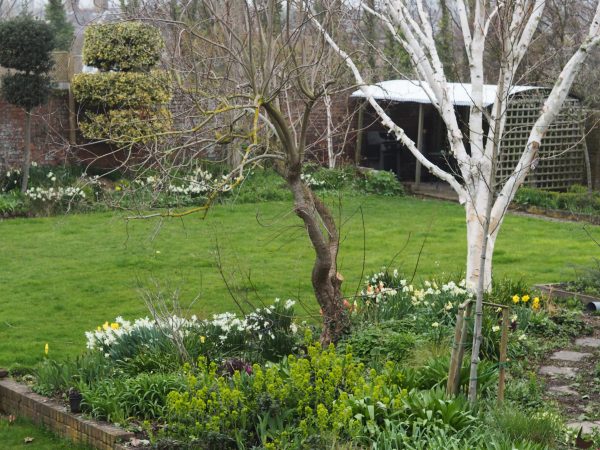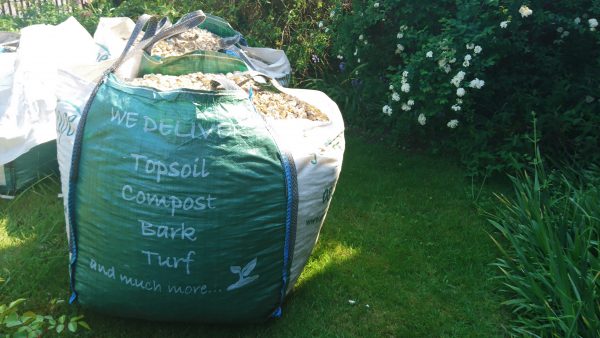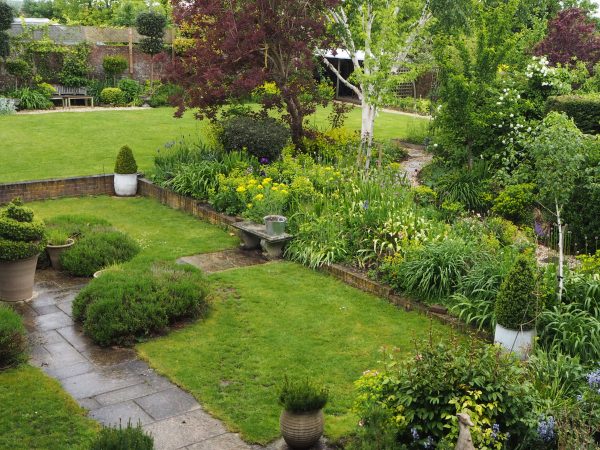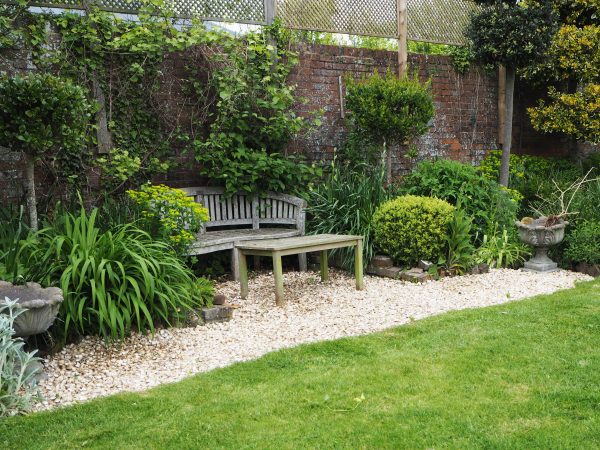A seashell garden path is probably the most environmentally friendly path option you can choose. It’s relatively cheap and you can lay it yourself.
And it’s not just for ‘seaside gardens’, either.

A seashell garden path made from cockle shell mulch in garden maker, Posy Gentles’ garden.
The shells are a by-product of the shellfish industry, so you’re immediately recycling.
And, like gravel, shell mulches allow rainwater to drain into the ground, so it’s not contributing to run-off.
A new path or renewing an old one?
If you have a gravel path, it may need renewing. We had our gravel paths topped up in 2010, and I reckon they are about half earth now.

After eight years, our gravel paths are half earth…that’s Lottie, by the way.
Meanwhile my friend, garden maker Posy Gentles, was creating a new path in her garden. She decided to use cockle shell mulch, so we decided to try it too, to revive our mucky-looking gravel paths.

The same garden path after we laid 20mm of seashell mulch on top.
Why not gravel?
Gravel is good! It’s a much more environmentally-friendly surface than stone or concrete. The RHS Greening Grey Britain campaign is trying to get us all to stop concreting over our front and back gardens.
They say that ‘paving over Great Britain is harmful to wildlife, damages the nation’s health and contributes to flooding.’
If you cover everything with hard landscaping, then you create run-off problems – when it rains, the water can’t soak into the earth properly. So it all rushes down our road (that’s what it feels like) and floods the basement of the house at the bottom. Well, that’s what happens here, anyway.
Gravel, sand and other mulches, such as bark or seashell mulches, allow plant roots to survive and water to drain freely. A gravel drive or front garden is much better for the environment than one that is completely paved over.

Close up of the seashell garden path mulch.
However, gravel does have to be extracted from lake, river and ocean beds, so it is using up natural resources. Seashell mulch is a byproduct of the seafood industry.
How to find a seashell garden path
It’s not easy to find seashell mulch. I couldn’t find any stocked at garden centres. so Posy ordered it online from Gardenscape Direct, who deliver around the South East of England.

There is a gravel and pavers path just to the right of the silver birch. Plus a gravel path running along the edge of the lawn to the pergola. But you ca barely see either as they are now about half earth.
If you live elsewhere, you can probably find someone to deliver in your area by searching online for ‘shell mulch’ and ‘seashell mulch.’
We had to calculate the volume of seashell mulch we needed. Mr Middlesize does the maths round here, and he estimated that we have 60 square metres of paths. And we thought that a depth of 20mm would be about right.
There’s a useful ‘how much do I need’ calculator on the Gardenscape Direct site, so we order two one-ton bags, to be delivered to our front garden.
Ordering in bulk
Ordering manures and mulches in bulk saves money, but you have to think about delivery. We have a walled garden in town, surrounded by other gardens. Our garden can only be accessed by a narrow, ancient walled alleyway.

Two one-tonne bags of seashell garden path mulch and one of mushroom compost land in the front garden one morning.
So the seashell mulch (plus a one ton bag of mushroom compost) had to be craned over the front fence into our front garden. Posy had her one ton bag craned onto her front path. These things need consideration if you’re going to go the DIY route for paths. If you hire landscapers, then they’ll probably wheelbarrow the mulches in from their truck with a wheelbarrow.
The hard work
Poor Mr M is also in charge of heavy lifting round here, and it took him 3-4 hours to wheelbarrow the seashell mulch from the front garden to the back. He tipped the wheelbarrow loads into piles in the garden where we wanted them.
It’s also worth saying that he prepared the paths beforehand, with a massive weeding effort. Although a mulch helps suppress weeds, it’ll be much more effective if poured on a path that is already weed-free.
Then we raked the piles over the paths. Cockle shell mulch isn’t as heavy as gravel, so this was a relatively easy job. If the path is just gravel, even I can rake it out (and I have a bad shoulder at the moment). However where our paths were partly flagstones and partly gravel, it was much more fiddly. It probably took about another two hours.
You can see Mr M hard at work in this video here:
Mr M says that ‘a young man could do it all far more quickly.’
Creating the path from scratch
Posy had two young men (her sons) to help. The three of them wheelbarrowed and raked her seashell garden path into shape in around four hours.

Posy’s recycled shed with its seashell garden path and pavers in front.
That included levelling the ground. If you’re making a path, you need to level it, or the seashell mulch will all be washed down to one end. You also need to level paths to make them safe for walking, and in order to set stone or concrete pavers in safely.
Posy didn’t lay the seashells on fabric or any other base, so she needed more seashell mulch than I did. She thinks around 40-50mm would be about right for a completely newly laid path (as compared to our 20mm for us to top up an established path.)
The verdict?
The seashell mulch was about a third cheaper than gravel (it cost us about £200, including delivery, to cover 60 sq metres of path). And laying it doesn’t need any DIY expertise.
I think the colour brightens the garden up, but in a natural way, so I’m pleased with it.

This photo looks down on the garden from a window, and you can see how the seashell mulch garden paths add definition and brightness.
Our dog was initially hesitant about walking on it, but is now completely happy about having a seashell garden path.
The shells break underfoot, so the path will compact quite quickly, becoming finer and less ‘seashell-y’ over time. It will ultimately be absorbed into the soil, although I don’t know how long that will take.

The shell mulch brightens this bench area.
But…?
We found the shells harder to spread in the paths that had stepping stones in them. Where you’re creating a new path (as Posy did) or if you’re renewing an all-gravel path, then seashell mulch is very easy to lay.
But trying to get the shells to settle well around pavers caused much swearing from Mr M. He has asked me ‘not to do experiments in future’.
However, it would have been exactly the same if we’d renewed the paths with gravel. Mr M cleared away some of the soil and gravel before we laid the seashell mulch down, but we are hoping that it will settle around the pavers over time.
Posy added pavers at the same time as laying the mulch, so they were able to make sure pavers and shells all came up to the same level.
Next Sunday…
Next Sunday, I will be with Steve Bradley and Phil Harrison on BBC Radio Kent Gardening, covering the RHS Chelsea Flower Show, so the blog will come out on Monday. Do tune in, and ask some questions!
Pin for reference:

The post A seashell garden path – is it the best and most attractive option? appeared first on The Middle-Sized Garden.
from The Middle-Sized Garden https://www.themiddlesizedgarden.co.uk/a-seashell-garden-path-is-it-the-best-and-most-attractive-option/
No comments:
Post a Comment